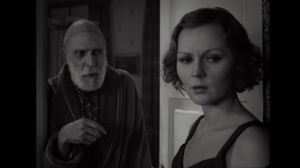As an editor, you probably appreciate a film with a solid organizing principle. An idea to which you can return, a theme that keeps things cohesive when dramatic events threatens to pull everything apart. Fortunately for you, Living Images keeps all of its action well-contained. Literally contained. The entirety of this multi-decade story is told from within the confines of a large estate in Tallinn, Estonia.
That's not to say the house itself is the main character. As the narrative traverses the 20th century, it's used to create different microcosms of Estonian society. The actual main characters are Julius and Helmi, both born in the old house to servants of the Baltic nobles who own it (each both played by a number of actors who depict them at various ages). Their stories weave through history as the house changes owners (and purposes) while Estonia is occupied by Germany, becomes an independent state, is once again occupied (this time by the Russians), and, finally, gains its independence once again, only to fall under the spell of capitalist greed.
That greed is the framing device for the film: Estonia's estates have become valuable in the new economy, and Helmi's grandson Paul wants to sell the old house to a foreign investor. Also valuable is the old cinema attached to the house, which Julius runs until its final showing (ominously enough, of the apocalyptic blockbuster Terminator 2: Judgement Day); the various owners of the house always find ways to use the small theatre as it suits them.
As an editor, this aspect of Living Images must have appealed to you; the history of cinema informs the style of the film itself. Director and co-writer Hardi Volmer shoots each episode of the story in a style representative of the era we find ourselves in: from scratchy silents, to silky black and whites, to garish technicolor. I can only imagine how fun it must have been to splice together and age the elements to achieve this effect. And it's a good thing Volmer decided on this technique, because storytelling-wise, Living Images is a bit of mess. Relationships (apart from Julius' unrequited love for Helmi) are not always clear, and this creates confusion as the years stack up. But maybe this isn't unintentional; these memories are codified by the popular storytelling medium of the time, and memories don't always adhere to logic.
At times, Living Images threatens to break under the weight of its story. There's a lot of Estonian history crammed into these past hundred years--so much that characters are sometimes simply describing what's happening outside the house. But Julius' two loves - Helmi and the movies - creates a foundation that is strong enough to support it all, and adds an emotion that, unlike the tumultuous events heap pending around them, snuck up on me in the final moments of the film.
To editors, the idea that "the whole is greater than the sum" is more than a cliche. But worse than using a cliche is not using the right words. And here they certainly fit.
Checking my math,
Casey







